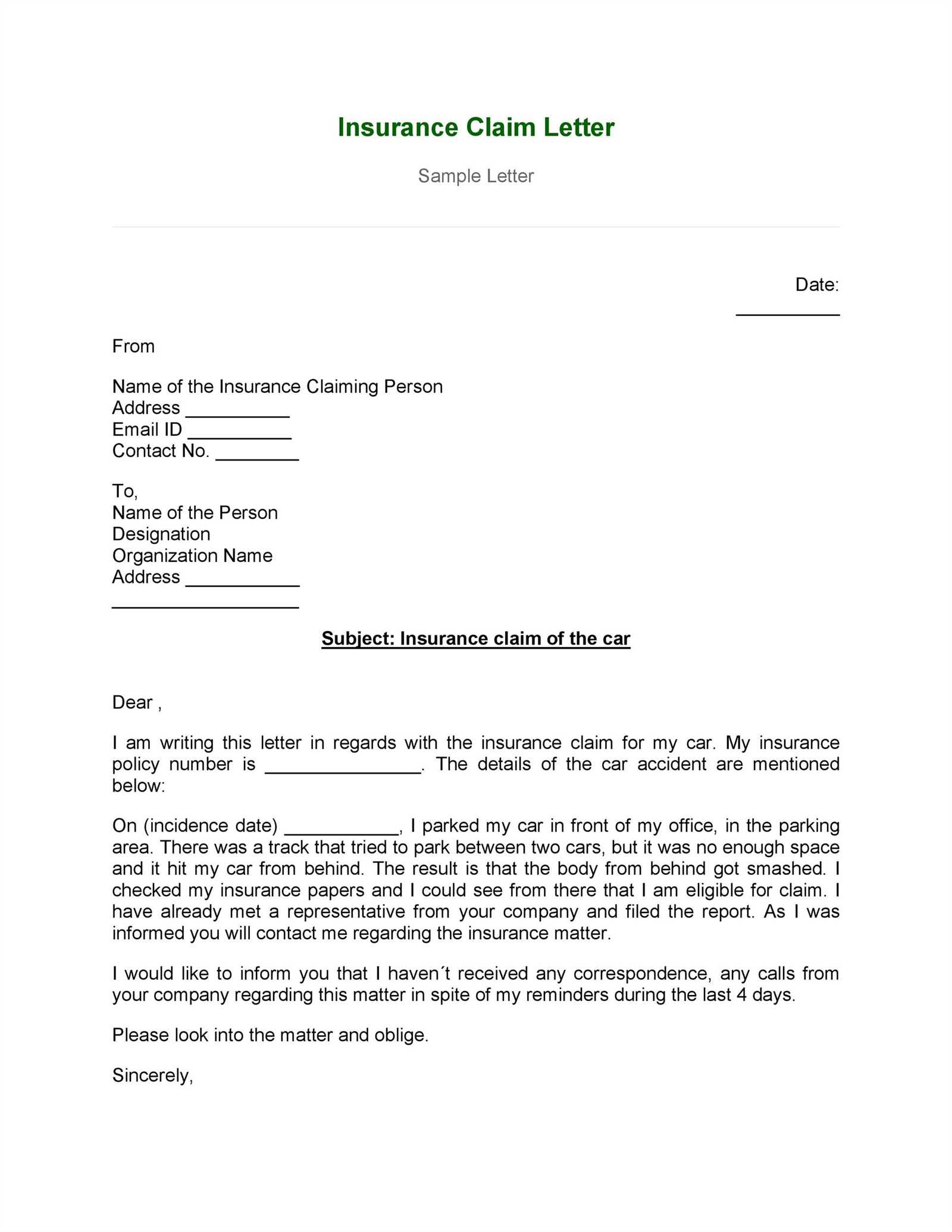Auto Accident Demand Letter Template for Claim Success

After being involved in a collision, one of the first steps towards seeking compensation is to formally present your case to the responsible party or their insurance. A well-crafted document can help you communicate your damages, losses, and expectations clearly, setting the stage for a successful resolution. Knowing how to structure this communication is essential to ensure it is taken seriously and leads to a fair outcome.
Effective communication in these situations is crucial. When drafting such a document, it’s important to focus on presenting facts and evidence in a structured way that highlights your needs. The goal is to make the recipient understand the extent of your injuries or damages and why you deserve compensation.
In this article, we will walk you through the key components that should be included in any well-written document intended for a claim settlement. Whether you’re addressing an insurer or a third party, understanding the essential elements of this communication can significantly improve your chances of receiving the amount you are entitled to.
Understanding Injury Claim Documents
When seeking compensation for damages or injuries, it is important to formally request a resolution through written communication. This document serves as a means to present your case clearly and outline the compensation you are entitled to. Crafting this communication requires attention to detail, as it will be the primary tool used to initiate negotiations or settlement discussions.
The purpose of such a document is to communicate the extent of your losses and provide the necessary evidence that justifies your compensation request. It should outline the damages, injuries, and other factors that influence the amount of settlement you are seeking.
Here are the key points that are typically included in a well-structured claim document:
- Clear explanation of the incident: Provide a detailed account of what happened and how it resulted in your injuries or property damage.
- Detailed list of damages: Break down both physical and financial damages incurred due to the incident.
- Supporting evidence: Include medical records, repair bills, and any other documents that substantiate your claim.
- Compensation request: Clearly state the amount of compensation you are seeking and how it was determined.
Properly composing this communication can set the stage for a more favorable settlement. It should convey professionalism, clarity, and reasonableness to ensure the recipient understands your position and takes it seriously.
Key Elements of a Strong Claim Document

When requesting compensation after an unfortunate event, it’s essential that your written communication is both precise and persuasive. A well-structured document provides a clear understanding of your case and lays out why compensation is warranted. To be effective, it must include specific components that will strengthen your position during negotiations.
Here are the essential elements of a robust claim document:
- Clear and detailed description of the incident: Start by giving a factual, concise account of what happened, focusing on key details that show how the event led to your injuries or damages.
- Explanation of injuries or damages: Provide a thorough description of both physical and financial damages, ensuring to include how they have impacted your daily life and well-being.
- Supporting evidence: Include medical reports, repair invoices, photos, or any other documents that substantiate your claims. These strengthen your case and demonstrate the validity of your request.
- Compensation calculation: Clearly state the amount you seek in compensation and explain how you arrived at that figure. This might involve factoring in medical expenses, lost wages, and other associated costs.
- Professional tone: Maintain a respectful and formal tone throughout the document, ensuring it reflects your seriousness in resolving the issue.
By incorporating these elements, you ensure that your communication is not only complete but compelling, improving the chances of a fair and swift resolution.
How to Draft Your Claim Request
Writing a formal request for compensation requires careful thought and structure. The goal is to present your case in a way that is both clear and persuasive, ensuring that the recipient understands the situation and is compelled to take your claim seriously. By following a systematic approach, you can increase your chances of achieving a favorable outcome.
Start by addressing the recipient properly, ensuring the communication is professional and respectful. Be sure to include the following key steps in your document:
- State the purpose: Begin by briefly explaining the intent of your communication–requesting compensation for the injuries or damages you have suffered.
- Provide a chronological account: Describe the events leading up to the incident, focusing on the facts and ensuring that your explanation is clear and straightforward.
- Detail your losses: Specify both tangible and intangible damages, such as medical bills, property repair costs, pain and suffering, or lost wages.
- Present evidence: Attach supporting documents, such as invoices, medical records, or photographs, to strengthen your claim.
- Specify your compensation request: Clearly state the amount you are seeking and explain how you arrived at that number based on your losses and expenses.
- Set a timeline: Let the recipient know by when you expect a response, encouraging timely action.
By following these steps, your request will be well-organized and persuasive, increasing your chances of a fair settlement.
Common Mistakes to Avoid in Claims
When pursuing compensation, there are several pitfalls that can weaken your case or even delay the resolution process. It’s essential to avoid common errors that may cause your request to be dismissed or cause unnecessary complications. Being mindful of these mistakes can help you navigate the process more effectively and increase your chances of success.
Failure to Provide Adequate Evidence
One of the most critical mistakes in filing for compensation is not providing enough supporting documentation. Whether it’s medical records, photos of damages, or repair bills, evidence is the backbone of your claim. Without it, your case may lack credibility, and your request could be denied or delayed.
Vague or Inaccurate Descriptions
Another common mistake is being unclear or imprecise when describing the incident or your losses. A well-written claim needs to present the facts in a detailed and structured manner. Avoid general statements that may confuse or undermine the strength of your case. The more specific and detailed you are, the better your chances of getting the compensation you’re seeking.
Negotiating After Sending the Request
Once you have submitted your claim and provided all necessary details, the next step is to enter into negotiations with the recipient or their representative. This phase is crucial in determining the final compensation amount and whether a settlement can be reached. Effective negotiation requires a clear understanding of your position and the ability to present your case convincingly.
Setting Realistic Expectations
Before entering into discussions, it’s important to have realistic expectations about the potential outcome. Negotiations often involve some back-and-forth, and the final offer may differ from your initial request. Be prepared to assess offers carefully and make adjustments if needed, without settling for less than you deserve.
Staying Professional and Calm
Maintaining a professional and composed demeanor throughout the negotiation process is key. Avoid becoming emotional or confrontational, as this can undermine your position. Approach each counteroffer thoughtfully, and always provide logical reasoning behind your responses.
| Step | Action | Goal |
|---|---|---|
| Initial Offer | Review the offer carefully | Understand the terms and evaluate fairness |
| Counteroffer | Make a reasonable counteroffer | Bring the offer closer to your desired outcome |
| Final Agreement | Agree on a compensation amount | Reach a mutually acceptable settlement |
Negotiation is often about finding a middle ground that both parties can agree on. Stay focused on your goals, and be ready to adjust your approach based on the situation to secure a fair resolution.
When to Seek Legal Assistance

In some cases, handling your claim independently may not be enough to secure the compensation you deserve. If the process becomes overwhelming or if you’re facing significant resistance, seeking legal help might be the best course of action. A lawyer can offer expertise in complex situations and provide guidance on how to proceed effectively.
When Negotiations Stall
If you’ve reached a point where negotiations are not progressing, or the opposing party is unwilling to make a fair offer, it’s time to consult a lawyer. Legal professionals can help ensure that your rights are protected and advocate for a resolution that aligns with your interests. They can also guide you on the next steps if further legal action is required.
Complex Cases or Severe Injuries
If your case involves severe injuries, substantial property damage, or complicated circumstances, having legal representation can make a significant difference. Lawyers with experience in similar cases can navigate the legal intricacies and help you get the maximum compensation possible. Their knowledge of local laws and negotiation tactics can be invaluable in securing a favorable outcome.